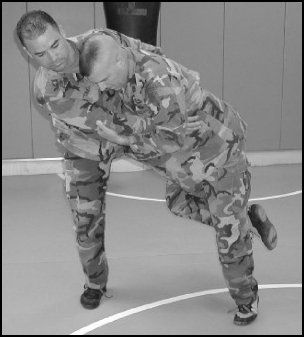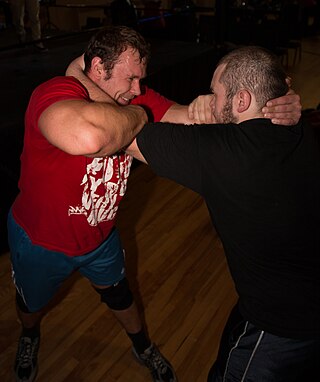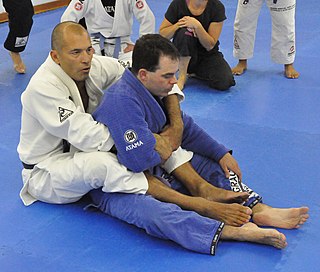
Grappling is a fighting technique as well as a full-contact combat sport based on throws, trips, sweeps, clinch fighting, ground fighting and submission holds.

Kickboxing is a full-contact combat sport and a form of boxing based on punching and kicking. The fight takes place in a boxing ring, normally with boxing gloves, mouth guards, shorts, and bare feet to favor the use of kicks. Kickboxing is practiced for self-defense, general fitness, or for competition. Some styles of kickboxing include: Karate, Muay Thai, Japanese kickboxing, Lethwei, Sanda, and Savate.
Professional wrestling throws are the application of professional wrestling techniques that involve lifting the opponent up and throwing or slamming them down. They are sometimes also called "power" maneuvers, as they are meant to emphasize a wrestler's strength. Many of these moves are used as finishers by various wrestlers, who refer to them by several different names that reflect their gimmick. Moves are listed under general categories whenever possible.
Professional wrestling holds include a number of set moves and pins used by performers to immobilize their opponents or lead to a submission. This article covers the various pins, stretches and transition holds used in the ring. Some wrestlers use these holds as their finishing maneuvers, often nicknaming them to reflect their character or persona. Moves are listed under general categories whenever possible.

A strike is a directed physical attack with either a part of the human body or with an inanimate object intended to cause blunt trauma or penetrating trauma upon an opponent.
A suplex is an offensive move used in sport wrestling as well as amateur wrestling and professional wrestling. It is a throw that involves lifting the opponents and bridging or rolling to slam them on their backs.

In martial arts and combat sports, a takedown is a technique that involves off-balancing an opponent and bringing them to the ground with the attacker landing on top. The process of quickly advancing on an opponent and attempting a takedown is known as shooting for a takedown, or simply shooting. Takedowns are usually distinguished from throws by amplitude and impact, where the purpose of a throw is to outright eliminate the opponent while purpose of a takedown is to bring the opponent down on the ground, assume a dominant position and then proceed to finish them with jointlocks, chokeholds or ground and pound. In rulesets of many sports such as Judo and Sambo, a well executed throw will end the match while the match will continue on the ground if a takedown is used instead. Takedowns are featured in all forms of wrestling and Judo.
In professional wrestling double-team maneuvers are executed by multiple wrestlers instead of one and typically are used by tag teams in tag team matches. Many of these maneuvers are combination of two throws, or submission holds. Most moves are known by the names that professional wrestlers give their "finishing move" names. Occasionally, these names become popular and are used regardless of the wrestler performing the technique. Moves are listed under general categories whenever possible.
An armlock in grappling is a single or double joint lock that hyperextends, hyperflexes or hyperrotates the elbow joint or shoulder joint. An armlock that hyper-extends the elbow is known as an armbar, and it includes the traditional armbar, the shoulder triangle armbar, and the shotgun armbar. An armlock that hyper-rotates the arm is known as an armcoil, and includes the americana, kimura, and omaplata. Depending on the joint flexibility of a person, armcoils can either hyper-rotate only the shoulder joint, only the elbow joint, or both the elbow joint and shoulder joint.

A knee strike is a strike with the knee, either with the kneecap or the surrounding area. Kneeing is a disallowed practice in many combat sports, especially to the head of a downed opponent. Styles such as kickboxing and several mixed martial arts organizations allow kneeing depending on the positioning of the fighters. Knee strikes are native to the traditional Southeast Asian martial arts and traditional Okinawan martial arts.

Clinch fighting is the part of stand-up fighting where the combatants are grappling in a clinch, typically using clinch holds. Clinching the opponent can be used to eliminate the opponent's effective usage of some kicks, punches, and melee weapons. The clinch can also be used as a medium to switch from stand-up fighting to ground fighting by using takedowns, throws or sweeps.

In wrestling, a bear hug, also known as a bodylock, is a grappling clinch hold and stand-up grappling position where the arms are wrapped around the opponent, either around the opponent's chest, midsection, or thighs, sometimes with one or both of the opponent's arms pinned to the opponent's body. The hands are locked around the opponent and the opponent is held tightly to the chest. The bear hug is a dominant position, with great control over the opponent, and also allows an easy takedown to the back mount position.

A grappling hold, commonly referred to simply as a hold that in Japanese is referred to as katame-waza, is any specific grappling, wrestling, judo, or other martial art grip that is applied to an opponent. Grappling holds are used principally to control the opponent and to advance in points or positioning. The holds may be categorized by their function, such as clinching, pinning, or submission, while others can be classified by their anatomical effect: chokehold, headlock, joint-lock, or compression lock. Multiple categories may be appropriate for some of these holds.

In wrestling, an overhook, also incorrectly called a wizard, is a clinch hold that is used to control the opponent. An overhook is performed from any direction by putting an arm over the opponent's arm, and encircling the opponent's arm or upper body. Having an overhook with one arm is called a single overhook, while having overhooks with both arms is known as double overhooks. Overhooks are typically employed in response to underhooks by an opponent.

A grappling position refers to the positioning and holds of combatants engaged in grappling. Combatants are said to be in a neutral position if neither is in a more favourable position. If one party has a clear advantage such as in the mount they are said to be in a "dominant position". Conversely, the other party is considered to be in an inferior position, usually called "on the bottom", but in this case sometimes called the "under mount".

A pinch grip tie, or an over-under bodylock, is a clinch hold and stand-up grappling position that is an extension of the over-under position, but having both hands locked behind the opponents back. The hands are typically locked with a palm-to-palm grip, palm-to-wrist grip or fingers-to-fingers grip. The pinch grip tie can be used to throw the opponent, but usually the grapplers attempt to obtain a better hold such as double underhooks or double collar tie. The pinch grip tie is often a neutral position when both grapplers symmetrically have the same hold on each other.

A collar-and-elbow hold is a stand-up grappling position where both combatants have a collar tie, and hold the opponent's other arm at the elbow. Generally the opening move in professional wrestling, the collar-and-elbow is generally a neutral position, but by pushing the hand on the elbow to the inside of the opponent's arms, and holding the biceps, more control can be obtained. From here it will be easier to strike or to attempt takedowns, while defending against the opponent's techniques.

Over–under is a stand-up grappling position in which both combatants have one overhook and one underhook, and is the most common stand-up grappling position in mixed martial arts. The head is typically on the same side as the overhooked arm, to allow greater weight to be put on the opponent's underhooked arm, and hence preventing the opponent from using the underhooked arm effectively. The over–under position can be advanced into a pinch grip tie by locking the hands behind the opponent's back.

Hooks is a term in grappling martial arts that generally refers to the use of careful positioning of a practitioner’s feet and legs to control and manipulate the movement or position of their opponent. One of the most common uses of hooks is in the back control position to prevent escape. However, a practitioner may alternatively use hooks to defend, sweep, or attack their opponent.













